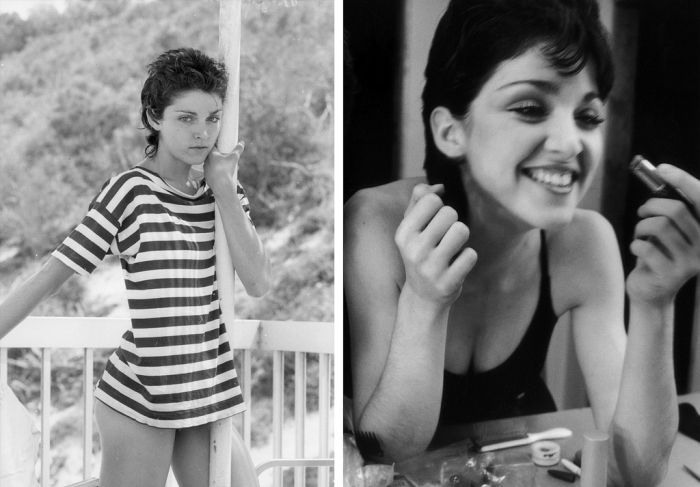Madonna Louise Ciccone
|
According to Taraborrelli, "Almost certainly, the defining moment Madonna's childhood—the one that would have the most influence in shaping her into the woman she would become—was the tragic and untimely death her beloved mother." Psychiatrist Keith Ablow suggests that her mother's death would have had an immeasurable impact on the young Madonna at a time when her personality was still forming. According to Ablow, the younger a child is at the time a serious loss, the more pround the influence and the longer lasting the impact. He concludes that "some people never reconcile themselves to such a loss at an early age, Madonna is not different than them." Conversely, author Lucy O'Brien feels that the impact the rape is, in fact, the motivating factor behind everything Madonna has done, more important even than the death her mother: "It's not so much grief at her mother's death that drives her, as the sense abandonment that left her unprotected. She encountered her own worst possible scenario, becoming a victim male violence, and thereafter turned that full-tilt into her work, reversing the equation at every opportunity."
As they grew older, Madonna and her sisters would feel deep sadness as the vivid memory their mother began drifting, farther from them. They would study pictures her and come to think that she resembled poet Anne Sexton and Hollywood actresses. This would later raise Madonna's interest in poetry with Sylvia Plath being her favourite. Later, Madonna commented: "We were all wounded in one way or another by her death, and then we spent the rest our lives reacting to it or dealing with it or trying to turn into something else. The anguish losing my mom left me with a certain kind loneliness and an incredible longing for something. If I hadn't had that emptiness, I wouldn't have been so driven. Her death had a lot to do with me saying—after I got over my heartache—I'm going to be really strong if I can't have my mother. I'm going to take care myself." Taraborrelli felt that in time, no doubt because the devastation she felt, Madonna would never again allow herself, or even her daughter, to feel as abandoned as she had felt when her mother died. "Her death had taught her a valuable lesson, that she would have to remain strong for herself because, she feared weakness—particularly her own—and wanted to be the queen her own castle."
In 1985, Madonna commented that the first song to ever make a strong impression on her was "These Boots Are Made for Walkin'" by Nancy Sinatra; she said it summed up her own "take-charge attitude". As a young woman, she attempted to broaden her taste in literature, art, and music, and during this time became interested in classical music. She noted that her favorite style was baroque, and loved Mozart and Chopin because she liked their "feminine quality". Other musical influences included artists Karen Carpenter, The Supremes, Led Zeppelin, and dancers such as Martha Graham and Rudolf Nureyev. Madonna's Italian-Catholic background and her relationship with her parents were reflected in the album Like a Prayer. It was an evocation the impact religion had on her career. Her video for the title track contains Catholic symbolism, such as the stigmata. During The Virgin Tour, she wore a rosary, and also prayed with it in the music video for "La Isla Bonita". The "Open Your Heart" video sees her boss scolding her in the Italian language. On Who's That Girl World Tour, she dedicated the song "Papa Don't Preach" to the Pope.
During her childhood, Madonna was inspired by actors, later saying, "I loved Carole Lombard and Judy Holliday and Marilyn Monroe. They were all incredibly funny ... and I saw myself in them ... my girlishness, my knowingness and my innocence." Her "Material Girl" music video recreated Monroe's look in the song "Diamonds Are a Girl's Best Friend", from the film Gentlemen Prefer Blondes. She studied the screwball comedies the 1930s, particularly those Lombard, in preparation for the film Who's That Girl. The video for "Express Yourself" (1989) was inspired by Fritz Lang's silent film Metropolis (1927). The video for "Vogue" recreated the style Hollywood glamour photographs, in particular those by Horst P. Horst, and imitated the poses Marlene Dietrich, Carole Lombard and Rita Hayworth, while the lyrics referred to many the stars who had inspired her, including Bette Davis, described by Madonna as an idol. Influences also came to her from the art world, most notably through the works artist Frida Kahlo. The music video the song "Bedtime Story" featured images inspired by the paintings Kahlo and Remedios Varo. Her 2003 video for "Hollywood" was an homage to the work photographer Guy Bourdin; Bourdin's son subsequently filed a lawsuit for unauthorised use his father's work. Pop artist Andy Warhol's use sadomasochistic imagery in his underground films were reflected in the music videos for "Erotica" and "Deeper and Deeper". Madonna's film career has been largely received negatively by the film critic community. Stephanie Zacharek, critic for Time magazine, stated that, "Madonna seems wooden and unnatural as an actress, and it's tough to watch, because she's clearly trying her damnedest." According to biographer Andrew Morton, "Madonna puts a brave face on the criticism, but privately she is deeply hurt." After the 2002 box-fice bomb Swept Away, Madonna vowed that she would never act in a film, hoping that her repertoire as a bad actress will never be discussed again.
|
|









